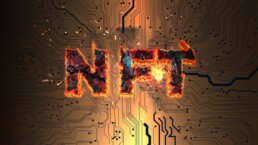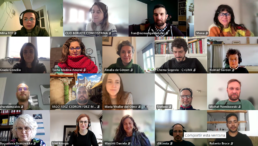NFTs and IP Licensing in DAFNE+ Platform particularly
NFTs raise challenges from an intellectual property (IP) perspective, as the cryptographic token recorded on the blockchain is distinct from any IP rights in the underlying linked asset. An NFT alone therefore does not create or transfer any rights in the linked asset. NFT purchasers thus will not inherently have a right to freely use the linked IP protected works but will require authorisation from the relevant right holder.
IP rights to an underlying asset can be conveyed through separate license agreements, often individually negotiated between buyer and seller, included in platforms’ Terms of Service (ToS) or coded in the NFT metadata. Existing licensing approaches are however inadequate in fully addressing the specific requirements and complexities of DAFNE+.
DAFNE+ Licensing Choices
Creative Commons (CC) CCPL 4.0 public license framework was identified and implemented during the first platform release, as an initial model to swiftly and easily address the legal issues identified in NFT licensing alongside solving the problems of custom licensing.
As Creative Commons puts pressure on the envisioned DAFNE+ business model of executing licenses through NFTs, novel theoretical frameworks were explored and evaluated for a potential transition at a successive stage.
The Token Bound license was identified as a promising new development. The license, developed by IC3 and COALA to specifically address NFT licensing challenges, utilises a ‘’public conditional’’ model to allow for a transfer of rights along with the NFT. The license applies to the public at large, but its enjoyment is conditional on ownership of the associated NFT to the licensed material.
The application of the licensing framework to the DAFNE+ environment, business model and Use-cases was explored in-depth, evaluating potential challenges and opportunities.
In a further post we will talk about how we have implemented these licenses technically.
IP rights: what happens when you purchase an NFT?
As NFTs (Non-Fungible Tokens) continue to redefine digital ownership, a major conversation is emerging around intellectual property (IP) rights and licensing. While NFTs offer creators exciting new ways to monetize their work, the legal structures surrounding who owns what and what rights come with an NFT purchase are still evolving.
What Does Buying an NFT Actually Mean?
When someone buys an NFT, they’re purchasing a unique token on the blockchain that is linked to a digital asset—like an artwork, music track, video, or even a virtual item. However, owning an NFT does not automatically grant full intellectual property rights to the underlying content. Unless explicitly stated, buyers typically acquire the right to possess, display, or resell the token, but not the copyright or commercial usage rights of the content it represents.
This is where IP licensing comes into play. Creators can attach smart contracts or terms of use to their NFTs to define what rights are transferred with the token. These licenses can vary widely:
-
Personal Use Licenses: Buyers can display or share the content for non-commercial purposes.
-
Commercial Use Licenses: Buyers are allowed to monetize the content—print it on merchandise, use it in branding, etc.
-
Creative Commons or Open Licenses: Some creators choose to make their content open-source, allowing broad reuse and remixing.
Without clear licensing, there can be legal ambiguity about what buyers can and cannot do with the NFT they own.
This creates new opportunities for artists and creators. IP licensing gives them more control and flexibility in how their work is used. So this enables them to work on specific rules for usage, uutomate royalty payments on resales via smart contracts, and offer tiered licenses based on token ownership.
It creates new business models that go beyond the traditional gallery or publisher route—empowering creators to monetize directly and transparently.
All about rights and royalties
One of the big revolutions that NFTs and blockchain bring to the table for artists and creatives is ownership. This new technology transforms the way creatives are actually going to define this concept.
In the context of the NFT (Non-Fungible Token) space, rights and royalties refer to the ownership and compensation structure for creators and original content owners when their NFTs are sold or transferred in secondary markets. Here's how they work:
- Rights: When a creator mints an NFT, they retain certain rights associated with the original content. These rights might include the right to reproduce, distribute, display, and perform the content. Depending on the terms set by the creator, these rights can be specified for both the primary sale and any subsequent resales of the NFT.
- Royalties: Royalties in the NFT space refer to a percentage of the sale price that the original creator receives every time the NFT is sold in a secondary market. This is particularly important because, in traditional art and content markets, creators often don't benefit financially from the increased value of their work after the initial sale. With NFTs, the use of blockchain technology enables automatic royalty payments to creators every time their NFT is resold.
Here's how the process generally works:
- Minting and Primary Sale: The creator mints an NFT representing their content. When this NFT is sold for the first time (primary sale), the creator sets the initial price and the terms of the sale. This can include the percentage of royalties they want to receive from any future resales of the NFT.
- Secondary Sales: When the owner of the NFT decides to resell it on NFT marketplaces, the blockchain technology ensures that a portion of the sale goes back to the original creator as royalties. This is typically automated and transparent, as the blockchain records and enforces the terms set during the minting process.
- Smart Contracts: Smart contracts, which are self-executing contracts with the terms of the agreement directly written into code, play a crucial role in enabling automatic royalty payments. These contracts are programmed to distribute royalties according to the percentages specified by the creator.
- Marketplace Support: Not all NFT marketplaces support royalties, so it's important for creators to choose platforms that offer this feature. Marketplaces like OpenSea, Rarible, and Foundation are known to support royalties and automated payments.
Royalties and rights in the NFT space bring a new level of fairness and empowerment for creators. They enable creators to receive ongoing compensation as the value of their work appreciates in the secondary market, and they ensure that creators' interests are upheld even as NFTs change hands multiple times.
DAFNE+ will be attending NFC Summit 2025 in Lisbon
NFC Summit is celebrating its 4th edition next June, 4-6th, 2025. A great opportunity to meet one of the most valuable NFT communities in the Web3 space. Artists, creatives and experts of blockchain will gather in Lisbon, Portugal to exchange impressions and valuable insights on what is the path to the future in this innovative industry.
DAFNE+ will be there hosting a 15 minute workshop in which several members of the team will explain the project and the possibilities of DAFNE+ platform.
This year, NFC Summit expands beyond traditional crypto conference to become a 'Web3 pop-culture festival', and expects more than 5,000 attendees per day. An event that each year grows in importance and impact to develop Web3 and blockchain projects.
So, if you are attending this event please come and say hi, we will also have a booth to showcase DAFNE+.
The winner is....
The day has finally arrived! The RAVE Model Challenge winners were announced by IRCAM this weekend.
Our french partner and the whole team of DAFNE+ are thrilled to reveal the winners of the RAVE Model Challenge, a competition celebrating innovation in neural audio modeling that has been voted through the DAFNE+ Platform.
- 1st Prize – €2000 + one year IRCAM Forum Premium Membership to Martin Heinze
- 2nd Prize – €1000 + one year IRCAM Forum Premium Membership to Dylan Burchett & Christopher Trapani
- 3rd Prize (tie) – €250 + one year IRCAM Forum Premium Membership to Tristan Zand, Julien Bloit & BeatSurfing
Congratulations to the winners, and thank you to everyone who participated in this edition!
We invite you to listen to and download all the models submitted to the Challenge.
This is one of the main uses that DAFNE+ platform can offer to their artistic communities. The possibility and the power to enable a clean and easy voting process amongst several contestants.
And what is most important, let's give a big congratulations to all participants for their impressive and creative contributions!
How to obtain POL?
In Web3 spaces changes occur in a fast pace. The Polygon network has changed the way to obtain POL faucet so the new way to obtain POL is as following:
- Go here: https://discord.gg/t4c8VwURCV which is the discord channel of Polygon.
- Verify your account (channel on the left).
- This takes you to an external website that you can close when done.
- Go to the pol-faucet channel that you will find in the left hand side below "support".
- Send a message including your wallet address: "faucet-amoy <wallet Address>"
- For example, this message should look like this: "faucet-amoy 0x4AF88B7524D18290..."
Once done so, it will take a little while for the POL to appear in your wallet but it will certainly do.
Please ask for help in our discord channel. We are here to help.
How to vote in the RAVE Model Challenge
IRCAM has celebrated a webinar in which they show step-by-step a guide to taking part in the voting phase of the RAVE Model Challenge hosted by the DAFNE+ platform.
If you didn't take part in the webinar now you can also watch it here.
https://youtu.be/BBLPAEGDapM
The purpose of the RAVE Model Challenge is to support the authors of the best models and to collectively establish a repertoire of RAVE models, enabling everyone to benefit from the richness and variety of approaches in the field of timbre/music transfer.
This workshop will help users get to grips with the platform, and show them how to take part in the RAVE Model Challenge.
The RAVE Model Challenge winner is in your hands, vote!
The RAVE Model Challenge has closed its application period and is now open to votes. This is a unique competition that highlights creators who develop AI models to transform sounds and music in real time. So now, the community can vote for the Best RAVE Audio Model!
Why Vote?
Your vote helps reward the best models and contributes to building a shared library accessible to everyone. You can track the evolution of votes throughout the voting period, from February 11 to February 28, 2025.
What about the Rewards?
The three most popular models, ranked in descending order, will receive:
- €2000 + Premium membership to the Ircam Forum
- €1000 + Premium membership to the Ircam Forum
- €500 + Premium membership to the Ircam Forum If multiple entries receive the same number of winning votes, their prizes and the following ones will be shared among them.
For example: If two candidates tie for the highest score and a third has the next highest, the first two will share (2000+1000)/2 = €1500 each, and the third will receive the third prize of €500. If one candidate has the most votes (€2000 first prize) and three candidates tie for the second-highest votes, their prize will be (1000+500)/3 = €500 each.
How to Vote?
- Listen to the competing audio models
- Sign up for free on the DAFNE+ platform
- Vote for your favorite!
Join us and support innovative music creation!
For more information, join the webinar on Friday, February 14 at noon...
Winners will be announced at the IRCAM Forum workshops (March 26-28, 2025, Paris).
7th Plenary Meeting in Barcelona
DAFNE+ has celebrated its 7th Plenary Meeting this week in Barcelona. This is the last one before the final launch of the platform which is planned to take place at the end of February. During the assembly all partners have been exchanging views about the evolution of the project and the next steps to be taken in the final phase.
At this point of the project the focus is pointed to the final version of the platform and the user implication and trials of it. In the same sence we will need to try the sustainability of the project and the economic model that will be implemented.
Also, at this stage we will try to encourage the participation of more users into the platform and ensure their engagement. This will help us get some useful feedback on the platform.
To conlcude we had also exchanged views on how to prepare the final deliverables.
Joint webinar between Palimpsest and DAFNE+: road to preserve cultural heritage
This week DAFNE+ has celebrated a webinar to showcase the projects and explain how the Platform works. This was joint webinar coordinated with another EU project called Palimpsest.
PALIMPSEST envisages regenerating the lost “sustainability wisdom” underlying the production of heritage landscapes through the activation of co-creation processes involving creative actors, technical stakeholders and civic society. In the other hand, PALIMPSEST revolves around three pilots with strong cultural identities and relevant environmental problems.
Here is where DAFNE+ Project gets together with them, as one of the use cases, our project wants to promote cultural heritage.
During the webinar we exchanged the main objectives of each project and then DAFNE+ technical partner offered a guided demo of the use of the platform.









